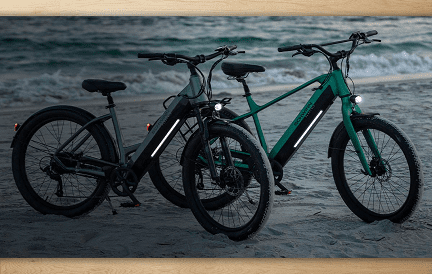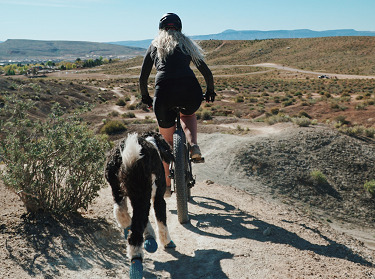Understanding the basic idea of how the bike’s gears function can assist us in selecting the appropriate gear for our bike. Especially in choosing the rear hub for your MTB. Here we will break down the single speed rear hub for you.
- Part 1: Product Overview
- Part 2: Product Advantages
- Part 3: Product Classification
- Part 4: Buying Guide
Part 1: Product Overview
A single speed bike is a bicycle with only one gear ratio. The hub is one area where we must pay close attention to. The hub is the center component of your bike’s wheels, and it may be found on both the front and back wheels. These hubs are used to connect the spokes of the wheel to the rim of the wheel where the bike’s axle is attached. The only elements of a mountain bike where continual noise isn’t an issue are the rear hubs. The front hubs merely roll along, but the rear hubs are a different story. The rear hub distributes the pedaling force to the rear wheel.

Single speed rear hub is designed to accommodate only one gear, such as one chainring and sprocket. A modified freewheel or a driver can be used to accomplish this. The cassette is mounted to the freewheel, while the wheel itself rotates on bearings within the hub around an axle. This allows the freewheel bike to move even when the pedal is in the idle position or is spinning backward. Rear hubs provide a number of purposes, they serve as a foundation for your work. The most significant purpose of the rear hub while riding is as a part of your mountain bike’s overall rolling efficiency, as it engages and disengages your pedal input to the rear wheel.
The rear single speed hub design aims to strike a compromise between mechanical complexity and serviceability. Engineers want to design rear hubs with a ratchet ring and engagement profile that allows for near-instantaneous pedal pickup. Precision manufacturing tolerances are found in the best mountain bike hubs, which reduce bearing play and contamination. A higher number of engagement points is also advantageous, as it reduces the time between pedal input and back wheel rotation.
Part 2: Product Advantages
The single speed hub has a distinct advantage in terms of wheel strength. It is possible to make a single speed wheelset stronger than a standard rear wheel. Because of the greater spoke spacing and a more symmetrical hub, this is the case. There are very few components on single speed hub bikes. As a result, single-speed motorcycles are frequently less expensive than multi-geared bikes. Maintenance comes at a lower cost as well. Many of the issues with a single-speed bike can be fixed by the typical rider. If they aren’t, most bike shops and mechanics can fix single-speed bikes faster than multi-gear bikes, resulting in less labor time and a cheaper overall cost.
These aren’t the only benefits. There are a few more advantages to using a single speed hub. The first is straightforwardness. Because we are only thinking about pedaling and breaking, our minds become considerably more focused. This allows us to focus more on the body and the pedaling rhythm. To some extent, we merely need to choose which route we will take and then relax and enjoy the ride. The second benefit is that it is low-maintenance.
It’s simple to maintain because there’s only one front gear and one back gear. Only the brake system needs to be examined. That is the only thing that needs to be checked, along with tire pressure and lubrication of the chain. There is no longer a shifting system that, if mismanaged, can cause an issue when riding. Third, because we don’t need to buy any extra gear components, building a one-speed bike is inexpensive. All we have to do now is find the crankset with the necessary gear and the cog that will be used. Finally, riding a single-speed bike makes you appear attractive and cool.
Part 3: Product Classification
Single-speed, freewheel, and internally geared rear hubs are the three types of mountain bike rear hubs. Rear single speed hub designed for only one gear is known as single-speed hub. A driver or a modified freewheel is used to do this. A freewheel design is used on standard mountain bike hubs, with a ratcheting body linked to the drive side of the hub onto which the cassette mounts. Internally geared rear hubs are also available, albeit they are uncommon.
This design does not require a derailleur. Instead of providing variable resistance through a system of springs and gears placed within the hub, some companies prefer loose pack bearings, while others prefer sealed bearings. Finally, there are two disc brake rotor standards: Centerlock and International Standard (six-bolt), both of which necessitate a unique hub design. Rear hubs come in a variety of sizes, shapes, and colors to fit any mountain riding situation. You can select the one that is most suited to your bicycle. Make certain that the model you purchase is compatible with your braking rotor.
Part 4: Buying Guide
Choosing the correct rear hub for your bike should be done with caution. You must take into account the bearing quality, the axle, and the number of ratchet teeth. The greater the overall mechanical efficiency of your rear hub bearings, the more spherically perfect they are. Less bearing friction is produced by a rounder form, and ceramic materials achieve this with better precision than steel. Ceramic hub bearings can be seated with tighter tolerances and less rotational friction than steel hub bearings. Ceramic bearings are also less susceptible to structural flex than steel bearings when under load. That means more durability for rear hubs, which typically have to deal with significant high-speed cornering side loads.
If you’re worried that your hub or frame choices will cause problems in the future, go with an adjustable rear hub with replaceable end caps or axle conversion kits. There is a simple way to read and comprehend how the amount of ratchet teeth affects the performance of your rear hub. For each degree your cranks revolve, a larger number of teeth will result in much faster engagement. This is the most efficient way to transport power.
Due to packing limits on a ratchet ring and the size of the hub shell, as the number of rear hub ratchet teeth rises, the individual teeth get smaller. Smaller teeth have a lower capacity to handle high torque input loads. As the rear hub engages from coasting to pedal stroke power input, fewer teeth allow for bigger individual metal profiles, which cope better with peak torque demands. Rapid engagement is preferred by most mountain bikers, especially those with 1×12 drivetrains because the risk of a peak torque load into their rear hub is low. As a result, a rear hub with additional teeth is required.
-
In Terms of Price
As previously said, single speed hub bikes are significantly less expensive than multi-geared bikes. This is due to the fact that simpler components require less upkeep. When there is an issue, we don’t necessarily have to take it to a bike shop to get it fixed. We can often complete the task on our own. Buying the hubs is something we should think about more. Because this is the most crucial aspect of a single-speed bike. However, there are a few things to think about before purchasing a hub. Make sure you know what size axle your bike frame requires, as well as whether an internally geared type is required. The type of hub you select will be determined by a number of criteria, including the type of bike, axle dimensions, riding style, and financial constraints. The pricing of single speed hubs varies since there are so many distinct types.
Different types of materials can play a part in determining pricing differences. Aluminum hubs, for example, can cost anything from $20 to $450. The carbon-based versions cost roughly $93,87. This is determined by the hub’s size and dimensions. You must examine which one is appropriate for your bike in order to choose the correct one. You must also consider your financial constraints. Axles range in price from roughly $8 to $15. The bearings, on the other hand, are highly dependent on the material from which they are made. The price of a ceramic bearing ranges between $22 and $25. Steel bearings are a little less expensive than their aluminum counterparts. They range in price from $9 to $10. So, it’s truly up to you to decide which one you want to buy for your bike.
-
Frame Material
MTB rear single speed hub and freewheel bodies are generally composed of lightweight aluminum alloy because it is light and strong, while carbon fiber units are also available on the market. The use of carbon fiber is intended to reduce weight. Carbon fiber is a composite of carbon sheets that are bonded together in a mold using resin. It is by far the most often used bike frame material for higher-end mountain and road bikes (including practically every bike race at the professional level). Carbon fiber has the primary advantage of being substantially lighter than aluminum, steel, or titanium at a given rigidity. Carbon frames absorb (rather than transmit) road vibration better because of their reduced density, resulting in a more comfortable ride. Carbon fiber may also be shaped into intricate shapes, offering bike designers more creative design freedom.
This is particularly beneficial when trying to maximize a frame’s aerodynamic efficiency. Titanium is a popular bike frame material among custom bike builders because it has many of the same qualities as steel but is more resistant to corrosion and fatigue. Titanium is also known for its smooth ride quality, which is comparable to (if not better than) carbon fiber. This makes it a popular material for custom road, touring, and hardtail mountain bikes. It’s also easier to repair than aluminum or carbon fiber, so if something goes wrong, you can get it fixed quickly. There are two possibilities for the width of the hub frame: 130 mm or 135 mm. MTB hub width is typically 135 mm, whereas 130 mm is more suitable for road bikes.
-
Wheel Size
The diameter and length of the rear axle determine the size of the rear hubs (in millimeters). We must be certain about the size of our bike’s rear hub, as this measurement is dependent on the frame’s design. 165×12, 157×12, 150×12, 142×12, 135×10, and 135×5 mm mountain bike sizes are available. The size of the wheels you’ll need for your bike will be determined by these measurements. Because MTBs are typically used off-road, their wheels have a significant impact on performance. You must be able to maintain good control of the bike when on the path, which is why you must have the proper wheel-set.
The phrase “single speed” is widely used to describe a freewheel one-speed bike, which can coast without the pedals moving. It used to be so straightforward. There was a set of 26 ” wheels mountain bikes available. However, as with any dynamic market, MTB wheels have been redeveloped and redesigned to meet the ever-changing landscape of Mountain Biking, incorporating different designs and ideas into various MTB disciplines in order to gain competitive and performance advantages over other cycle brands and manufacturers.
29″ wheels have been around for a lot longer than you might suppose. They were considered as a means of bringing additional speed to mountain biking. 29ers roll over the ground faster than its 27.5/26″ rivals. The 27.5″ wheel, which is quick turning, nimble, versatile, and fast, provides the ideal middle ground for many riders, which is why it has had such rapid success. With the majority of bikers being more accustomed to 26″, a 27.5″ wheel provides a natural step-up that is easily accepted.









